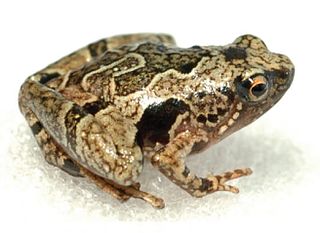
Kalophrynus is a genus of microhylid frogs. It is the only genus in the subfamily Kalophryninae. The species in this genus are found in southern China, in Southeast Asia to Java and Philippines, and in Assam, India.

Leptobrachium montanum is a species of frog from the family Megophryidae. It is endemic to Borneo and is, as currently defined, found in Kalimantan (Indonesia), Sabah and Sarawak (Malaysia), and Labi, Belait (Brunei). However, the nominal Leptobrachium montanum is a composed of more than one lineage. Available information mostly refers to this composite rather than the "true" Leptobrachium montanum. Common names montane large-eyed litter frog, mountain spadefoot toad, and mountain litter frog have been coined for it.
Arcovomer is a genus of frogs in the family Microhylidae. It is monotypic, being represented by the single species Arcovomer passarellii, commonly known as Passarelli's frog. It is endemic to south-eastern Brazil and found in Espírito Santo, Rio de Janeiro, and São Paulo states. Frogs from Espírito Santo may represent another, undescribed species. The name honours Antonio Passarelli who collected the holotype.

Glyphoglossus brooksii is a species of frog in the family Microhylidae. It is endemic to Borneo and found in Kalimantan (Indonesia) and Sarawak (Malaysia). Its common names are Brooks' squat frog and Brooks' burrowing frog. It is named after Mr. Cecil J. Brooks who collected the holotype "in a hole whilst prospecting" in Bidi, Sarawak.
Glyphoglossus smithi, also known as Smith's squat frog or Smith's burrowing frog, is a species of frog in the family Microhylidae. It is endemic to Sabah and Sarawak in Malaysian Borneo. However, it is likely to occur more widely than currently known and be present in Brunei and Indonesia. The specific name smithi honours Dr Harrison Willard Smith, an American scientist who collected the holotype from the Limbang River district.
Kalophrynus baluensis is a species of frog in the family Microhylidae. It is endemic to Mount Kinabalu in Sabah.
Kalophrynus intermedius is a species of frog in the family Microhylidae. It is endemic to Borneo and is found in Brunei, south-central Sarawak (Malaysia), and Kalimantan (Indonesia). Common names intermediate sticky frog, Sarawak grainy frog, and Mengiong sticky frog have been proposed for it.
Kalophrynus menglienicus is a species of frog in the family Microhylidae. It is known from the vicinity of its type locality in Menglian County in southern Yunnan, China, and from northern Vietnam; it is likely to occur in adjacent Myanmar and northern Laos. Common names Menglien grainy frog, Menglien narrow-mouthed frog, and Menglien dwarf sticky frog have been coined for this species, in reference to the type locality, as is the specific name menglienicus.
Kalophrynus minusculus is a species of frog in the family Microhylidae. It is endemic to Indonesia and occurs on extreme western Java and on the southeastern tip of Sumatra. It is a relatively small frog, as suggested by its specific name minusculus and vernacular names small sticky frog and dwarf sticky frog.
Kalophrynus nubicola is a species of frog in the family Microhylidae. It is endemic to Sarawak in Malaysian Borneo and is only known from the Gunung Mulu National Park. The specific name nubicola means "dwelling in cloud". Common names blue-spotted sticky frog and mossy-forest sticky frog has been coined for this species.
Kalophrynus robinsoni is a species of frog in the family Microhylidae. It is endemic to Pahang in central Peninsular Malaysia. The specific name robinsoni honours Herbert C. Robinson, a British zoologist and ornithologist. This poorly known species has not been reported since 1922.
Kalophrynus subterrestris is a species of frog in the family Microhylidae. It endemic to Borneo where it is known from Sabah and Sarawak (Malaysia), although it is also presumed to be present in Kalimantan (Indonesia) and Brunei. Common names burrowing grainy frog and Labang sticky frog have been coined for this species.

Nanohyla perparva is a diminutive species of frog in the family Microhylidae. It is endemic to Borneo and found in Kalimantan (Indonesia), Brunei, and Sabah and Sarawak (Malaysia). The nominal species includes distinct lineages that likely represent different species. Common names least narrow-mouthed frog and Labang forest rice frog have been proposed for this species.

Nanohyla petrigena is a species of frog in the family Microhylidae. It is found in northern and central Borneo and in the Sulu Archipelago of the Philippines. The common names pothole narrow-mouthed frog and Kapit rice frog have been coined for the species.

Stumpffia pygmaea is a species of frog in the family Microhylidae. It is endemic to Madagascar, where it is known from only two islands, Nosy Be and Nosy Komba. Its natural habitats are subtropical or tropical moist lowland forests, plantations.
Meristogenys macrophthalmus is a species of frog in the family Ranidae. It is endemic to Sarawak in northern Borneo (Malaysia) and is only known from its type locality in the Bintulu District. The specific name macrophthalmus is derived from the Greek words macros (="large") and ophthalmos (="eye") and refers to the large eyes of this frog. Common names Matsui's Borneo frog, large-eyed torrent frog, and big-eyed torrent frog have been coined for it.
Choerophryne grylloides is a small species of frog in the family Microhylidae. It is endemic to the upper Sepik River basin in the northern side of the New Guinea Highlands in Papua New Guinea. The specific name grylloides, from Latin gryllus ("cricket") and Greek suffix -oides ("resembles"), alludes to its cricket-like, high-pitched advertisement call.
Ansonia teneritas, the gracile slender toad, is a species of toad in the family Bufonidae, described in 2016. It is endemic to central Sarawak in Malaysian Borneo and is only known from two isolated mountain ridges. Its name is derived from its slender body.
Kalophrynus yongi is a species of frog in the family Microhylidae, also known as the Cameron Highland sticky frog. It is endemic to Peninsular Malaysia and is only known from its type locality near the top of Gunung Brinchang, in the Cameron Highlands, Pahang state. The specific name yongi honours Dr. Yong Hoi-Sen, a zoologist from the University of Malaya.
Leptobrachella bondangensis is a species of frog in the family Megophryidae. It is endemic to Central Kalimantan, in the Indonesian part of Borneo, and is only known from its eponymous type locality, Mount Bondang in the Murung Raya Regency. Common name Bondang dwarf litter frog has been coined for this species.







